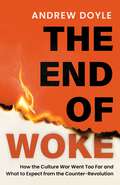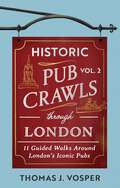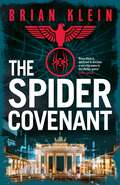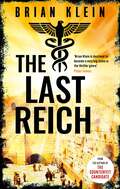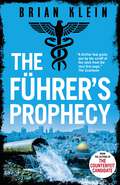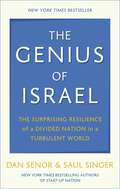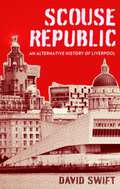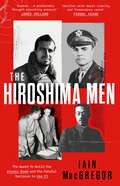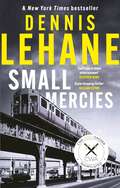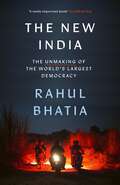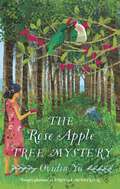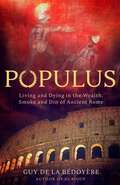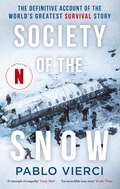- Table View
- List View
Skunk Works: A Personal Memoir of My Years at Lockheed
by Leo Janos Ben R. RichThe former head of Lockheed's SKUNK WORKS reveals the amazing story of the secret aircraft that changed the course of history - from the U-2 to the Stealth Fighter. A must-read for anyone interested in aviation, advanced technologies, Cold War history, and thrilling true stories.SKUNK WORKS is the true story, told for the first time, of America's most secret and successful aerospace operation. As recounted by Ben Rich, the operation's brilliant boss for nearly two decades, the story of Lockheed's legendary Skunk Works is a high-stakes drama of Cold War confrontations and Gulf War air combat, of extraordinary feats of engineering and human achievement against fantastic odds.SKUNK WORKS is dramatic and immediate. Direct from the cockpits of these astonishing aircraft - U-2 spy-plane, SR-71 Blackbird and F-117 Stealth Fighter. It is a tribute to genius in the unrelenting contest for mastery of the skies.
THE END OF WOKE: How the Culture War Went Too Far and What to Expect from the Counter-Revolution
by Andrew DoyleA revelatory investigation into the rise and fall of the 'woke' movement and how we can prevent it from happening again. It is no secret that we are in the midst of a cultural revolution. Activists in the 'woke' movement have claimed to be on the right side of history, and yet their approach has been intolerant, intemperate and, above all, illiberal. Having dominated the western world for the past fifteen years, there are clear signs the woke are now losing their power. The re-election of Donald Trump, the scaling back of DEI initiatives, and a growing awareness of the threats to women's sex-based rights has stirred a counter-revolution. But is this truly the end of woke? Or have the culture wars merely evolved?In The End of Woke, Doyle skilfully examines the mechanisms underlying the zealous extremes on both the left and the right. He shows that, in a desperate power struggle to re-assert liberal values, some leaders of the anti-woke movement have found themselves adopting a different kind of authoritarian approach - one which also promotes censorship and erodes our freedoms.Doyle argues that although authoritarianism is common to all political tribes, we must resist its pernicious influence wherever it emerges. After all, replacing one form of tyranny with another will not end the culture wars. But liberalism - true liberalism - might just see the end of woke for good.
THE END OF WOKE: How the Culture War Went Too Far and What to Expect from the Counter-Revolution
by Andrew DoyleA revelatory investigation into the rise and fall of the 'woke' movement and how we can prevent it from happening again. It is no secret that we are in the midst of a cultural revolution. Activists in the 'woke' movement have claimed to be on the right side of history, and yet their approach has been intolerant, intemperate and, above all, illiberal. Having dominated the western world for the past fifteen years, there are clear signs the woke are now losing their power. The re-election of Donald Trump, the scaling back of DEI initiatives, and a growing awareness of the threats to women's sex-based rights has stirred a counter-revolution. But is this truly the end of woke? Or have the culture wars merely evolved?In The End of Woke, Doyle skilfully examines the mechanisms underlying the zealous extremes on both the left and the right. He shows that, in a desperate power struggle to re-assert liberal values, some leaders of the anti-woke movement have found themselves adopting a different kind of authoritarian approach - one which also promotes censorship and erodes our freedoms.Doyle argues that although authoritarianism is common to all political tribes, we must resist its pernicious influence wherever it emerges. After all, replacing one form of tyranny with another will not end the culture wars. But liberalism - true liberalism - might just see the end of woke for good.
Historic Pub Crawls Through London, Vol. 2: 11 Guided Walks Around London's Iconic Pubs and Landmarks - the perfect gift for Father's Day (Historic Pub Crawls)
by Thomas J. VosperAfter spontaneously hosting a birthday pub crawl through London's finest alehouses, Thomas J. Vosper was inundated with requests from friends and family to make it a regular occurrence. And so, Historic Pub Crawls was born; a curated guide of fun, accessible and fact-filled walks which have taken social media by storm.Covering areas such as Mayfair, Regent's Park, Shoreditch and Richmond, this guide takes you on expertly curated walks through 10-15 historic pubs across the heart of the capital. Sip a pint overlooking the Thames, wander past the awe-inspiring Royal Albert Hall, take a stroll through Jack the Ripper's neighbourhood, or admire the iconic collections at the British Museum.Whether you're a history buff, a beer enthusiast, or just up for a great day out, this book is your ticket to unforgettable pub adventures. Grab a copy, gather your mates, and start your crawl
Historic Pub Crawls Through London, Vol. 2: 11 Guided Walks Around London's Iconic Pubs and Landmarks - the perfect gift for Father's Day (Historic Pub Crawls)
by Thomas J. VosperAfter spontaneously hosting a birthday pub crawl through London's finest alehouses, Thomas J. Vosper was inundated with requests from friends and family to make it a regular occurrence. And so, Historic Pub Crawls was born; a curated guide of fun, accessible and fact-filled walks which have taken social media by storm.Covering areas such as Mayfair, Regent's Park, Shoreditch and Richmond, this guide takes you on expertly curated walks through 10-15 historic pubs across the heart of the capital. Sip a pint overlooking the Thames, wander past the awe-inspiring Royal Albert Hall, take a stroll through Jack the Ripper's neighbourhood, or admire the iconic collections at the British Museum.Whether you're a history buff, a beer enthusiast, or just up for a great day out, this book is your ticket to unforgettable pub adventures. Grab a copy, gather your mates, and start your crawl
The Spider Covenant
by Brian KleinOn 10 August 1944, with Germany on the verge of a crushing and humiliating defeat, Heinrich Himmler, the second most powerful Nazi and head of the notorious SS, holds a clandestine meeting in Strasbourg, with a handful of elite industrialists and bankers.A covert organisation is born, codenamed 'Die Spinne' - The Spider. The network is tasked with helping senior SS officers escape the clutches of advancing allied forces. New identities are created, bankrolled by illicit funds, allowing notorious criminals to begin new lives in Europe and South America. Many of them land key roles in the worlds of politics, banking and industry. Decades later, they're able to pass on a privileged and influential birth right to their descendants.Himmler's secret lovechild, Amelie, is also spirited out of Germany by 'Die ,armed with a Nazi nest egg of fifty million dollars. Eighty years on, Amelie's adopted son becomes the head of the Spider network, which has evolved, survived and prospered over the decades under a cloak of secrecy.Employing a level of AI technology years ahead of anything currently known, the Spider network operates a secret facility based in Strasbourg, capable of creating undetectable Deepfakes of their own extremist politicians: perfect avatars, capable of conducting live interviews on a video stream with any news outlet in the world. The computer 'brain' of the Deepfakes is linked to state-of-the-art AI machines, programmed to create the perfect politician, spouting extreme right-wing rhetoric, aimed at winning over the masses. At a time of world disorder, with bitter wars across and the Middle East, the leaders of the Spider network look to seize their opportunity of grabbing control of the levers of political power.
The Spider Covenant
by Brian KleinOn 10 August 1944, with Germany on the verge of a crushing and humiliating defeat, Heinrich Himmler, the second most powerful Nazi and head of the notorious SS, holds a clandestine meeting in Strasbourg, with a handful of elite industrialists and bankers.A covert organisation is born, codenamed 'Die Spinne' - The Spider. The network is tasked with helping senior SS officers escape the clutches of advancing allied forces. New identities are created, bankrolled by illicit funds, allowing notorious criminals to begin new lives in Europe and South America. Many of them land key roles in the worlds of politics, banking and industry. Decades later, they're able to pass on a privileged and influential birth right to their descendants.Himmler's secret lovechild, Amelie, is also spirited out of Germany by 'Die ,armed with a Nazi nest egg of fifty million dollars. Eighty years on, Amelie's adopted son becomes the head of the Spider network, which has evolved, survived and prospered over the decades under a cloak of secrecy.Employing a level of AI technology years ahead of anything currently known, the Spider network operates a secret facility based in Strasbourg, capable of creating undetectable Deepfakes of their own extremist politicians: perfect avatars, capable of conducting live interviews on a video stream with any news outlet in the world. The computer 'brain' of the Deepfakes is linked to state-of-the-art AI machines, programmed to create the perfect politician, spouting extreme right-wing rhetoric, aimed at winning over the masses. At a time of world disorder, with bitter wars across and the Middle East, the leaders of the Spider network look to seize their opportunity of grabbing control of the levers of political power.
The Last Reich (The Reich Trilogy)
by Brian KleinA heinous, co-ordinated plot to attack a series of prominent synagogues, located across five different continents, is scheduled to take place on Yom Kippur - the Jewish Day of Atonement. For that one day of the year, celebrated prayer houses will be packed to the rafters with Jewish worshippers and the results could prove to be devastating. The mastermind behind the attacks is a direct blood descendant of Adolf Hitler - his grandson, former Republican presidential candidate, John Franklin. Artfully manipulating a number of fanatical, Neo-Nazi para-military groups across the globe, Franklin is looking to fulfil his grandfather's legacy and land a major blow against Jews located across the world.But in reality, the attacks are nothing more than an ingenious smokescreen for a far more sinister plot, which if successful, could severely unbalance geo-politics in the Middle East, sparking a global war between the Superpowers.Chief Inspector Nicholas Vargas of The Buenos Aires Police Department and Troy Hembury, the Head of Internal Security for the White House combine forces with senior colleagues at the FBI and Mossad, in a race against time to try to uncover the truth behind "Operation Atonement" and thwart the plan, as the consequences of failure could be disastrous for world peace.
The Last Reich (The Reich Trilogy)
by Brian KleinA heinous, co-ordinated plot to attack a series of prominent synagogues, located across five different continents, is scheduled to take place on Yom Kippur - the Jewish Day of Atonement. For that one day of the year, celebrated prayer houses will be packed to the rafters with Jewish worshippers and the results could prove to be devastating. The mastermind behind the attacks is a direct blood descendant of Adolf Hitler - his grandson, former Republican presidential candidate, John Franklin. Artfully manipulating a number of fanatical, Neo-Nazi para-military groups across the globe, Franklin is looking to fulfil his grandfather's legacy and land a major blow against Jews located across the world.But in reality, the attacks are nothing more than an ingenious smokescreen for a far more sinister plot, which if successful, could severely unbalance geo-politics in the Middle East, sparking a global war between the Superpowers.Chief Inspector Nicholas Vargas of The Buenos Aires Police Department and Troy Hembury, the Head of Internal Security for the White House combine forces with senior colleagues at the FBI and Mossad, in a race against time to try to uncover the truth behind "Operation Atonement" and thwart the plan, as the consequences of failure could be disastrous for world peace.
The Führer’s Prophecy (The Reich Trilogy)
by Brian KleinJanuary, 1939Adolf Hitler makes an infamous speech at the Reichstag threatening 'the annihilation of the Jewish race in Europe'. This vile public proclamation is seized upon by his fanatical supporters who christen it 'The Führer's Prophecy'.November, 1943A sinister plot hatched inside Block 10 of the notorious Auschwitz deathcamp is known only to a handful of Nazis as Operation Gesamtkunstwerk. It's a plan originated by Hitler, Himmler and Mengele and now, almost eighty years later, it's finally ready to be actioned by the direct descendants of the Führer.April, 2022As the world emerges from the Covid pandemic, an encrypted zoom call involving five participants, based across four continents, approves a plan that could have unimaginable consequences for the State of Israel. Chief Inspector Nicolas Vargas of the Buenos Aires Police Department and Lieutenant Troy Hembury of the LAPD join forces with Lea Katz, an elite Mossad agent, in a race against time to try and prevent the unthinkable consequences of Operation Gesamtkunstwerk.
The Führer’s Prophecy (The Reich Trilogy)
by Brian KleinJanuary, 1939Adolf Hitler makes an infamous speech at the Reichstag threatening 'the annihilation of the Jewish race in Europe'. This vile public proclamation is seized upon by his fanatical supporters who christen it 'The Führer's Prophecy'.November, 1943A sinister plot hatched inside Block 10 of the notorious Auschwitz deathcamp is known only to a handful of Nazis as Operation Gesamtkunstwerk. It's a plan originated by Hitler, Himmler and Mengele and now, almost eighty years later, it's finally ready to be actioned by the direct descendants of the Führer.April, 2022As the world emerges from the Covid pandemic, an encrypted zoom call involving five participants, based across four continents, approves a plan that could have unimaginable consequences for the State of Israel. Chief Inspector Nicolas Vargas of the Buenos Aires Police Department and Lieutenant Troy Hembury of the LAPD join forces with Lea Katz, an elite Mossad agent, in a race against time to try and prevent the unthinkable consequences of Operation Gesamtkunstwerk.
The Counterfeit Candidate (The Reich Trilogy)
by Brian KleinBerlin, 30 April, 1945As the Russian Army closes in on the war-torn City, Adolf Hitler and Eva Braun take their own lives. Their bodies are burned and buried in the Reich Chancellery garden, above the Führer's bunker.Buenos Aires, 9 January, 2012Three audacious thieves carry out the biggest safe depository heist in Argentine history, escaping with more than one hundred million dollars' worth of valuables. Within hours, an encrypted phone call to America triggers a blood-soaked manhunt as the thieves are tracked down, systematically tortured, then murdered.San Francisco, 18 January, 2012Senator John Franklin, hailed as the 'Great Unifier', secures the Republican Presidential nomination and seems destined for the Oval Office. Despite the sixty-seven year interval and a span of thirteen thousand miles, these events are indelibly linked.Chief Inspector Nicolas Vargas of the Buenos Aires Police Department and Lieutenant Troy Hembury of the LAPD are sucked into a dark political conspiracy concealing an incredible historical truth stretching from the infamous Berlin bunker to Buenos Aires and to Washington, which threatens the very heart and soul of American democracy.
The Counterfeit Candidate (The Reich Trilogy)
by Brian KleinBerlin, 30 April, 1945As the Russian Army closes in on the war-torn City, Adolf Hitler and Eva Braun take their own lives. Their bodies are burned and buried in the Reich Chancellery garden, above the Führer's bunker.Buenos Aires, 9 January, 2012Three audacious thieves carry out the biggest safe depository heist in Argentine history, escaping with more than one hundred million dollars' worth of valuables. Within hours, an encrypted phone call to America triggers a blood-soaked manhunt as the thieves are tracked down, systematically tortured, then murdered.San Francisco, 18 January, 2012Senator John Franklin, hailed as the 'Great Unifier', secures the Republican Presidential nomination and seems destined for the Oval Office. Despite the sixty-seven year interval and a span of thirteen thousand miles, these events are indelibly linked.Chief Inspector Nicolas Vargas of the Buenos Aires Police Department and Lieutenant Troy Hembury of the LAPD are sucked into a dark political conspiracy concealing an incredible historical truth stretching from the infamous Berlin bunker to Buenos Aires and to Washington, which threatens the very heart and soul of American democracy.
The Genius of Israel
by Dan Senor Saul SingerHow has a small nation of 9 million people, forced to fight for its existence and security since its founding and riven by ethnic, religious, and economic divides, proven resistant to so many of the societal ills plaguing other wealthy democracies?Why do Israelis have among the world's highest life expectancies and lowest rates of "deaths of despair" from suicide and substance abuse? Why is Israel's population young and growing while all other wealthy democracies are aging and shrinking? How can it be that Israel, according to a United Nations ranking, is the fourth happiest nation in the world? Why do Israelis tend to look to the future with hope, optimism, and purpose while the rest of the West struggles with an epidemic of loneliness, teen depression, and social decline?Dan Senor and Saul Singer, the writers behind the international bestseller Start-Up Nation, have long been students of the global innovation race. But as they spent time with Israel's entrepreneurs and political leaders, soldiers and students, scientists and activists, ultra-Orthodox Jews, Tel Aviv techies, and Israeli Arabs, they realized that they had missed what really sets Israel apart.
Scouse Republic: An Alternative History of Liverpool
by David Swift'Liverpool beguiles, Liverpool bewilders. Swift's superb analysis gets to the scarred heart of this troubled, beautiful and spirited city' Paul Du Noyer'[Swift] has a terrific eye for the telling detail . . . You should read this book' GuardianLiverpool is a unique city within the United Kingdom; its dialect, hedonism, friendliness, rejection of 'Englishness' and, most pertinently, its politics, all make for a rich cultural landscape. Yet, many of the things that make Liverpool the city it is today were not always at the fore. Furthermore, the complexity of the city, and an investigation into all aspects of its past, has not been readily available - until now.In Scouse Republic, David Swift expertly tracks the city's transformation from a humble village to a central component of the transatlantic slave trade and one of the most important ports in the world; from a stronghold of working-class Toryism to a bastion of left-wing politics, and analyses how the two manifest today. Swift interrogates the myths surrounding the city, offering a fully rounded perspective that considers both Liverpool's triumphs and tragedies, cleverly demonstrating how its remarkable evolution has added to the city's distinctive status. After all, in order to understand Liverpool, we need to understand its idiosyncrasies - all of which are key to comprehending modern Britain today, particularly in relation to racism, empire, deindustrialisation, immigration, popular culture and more.Interspersed with personal anecdotes from Swift, who was born and bred in Liverpool, Scouse Republic is the untold history of one of the UK's most iconic cities. Brilliantly researched and deeply compelling, it illustrates that there is far more to Liverpool than meets the eye.
Scouse Republic: An Alternative History of Liverpool
by David Swift'Liverpool beguiles, Liverpool bewilders. Swift's superb analysis gets to the scarred heart of this troubled, beautiful and spirited city' Paul Du Noyer'[Swift] has a terrific eye for the telling detail . . . You should read this book' GuardianLiverpool is a unique city within the United Kingdom; its dialect, hedonism, friendliness, rejection of 'Englishness' and, most pertinently, its politics, all make for a rich cultural landscape. Yet, many of the things that make Liverpool the city it is today were not always at the fore. Furthermore, the complexity of the city, and an investigation into all aspects of its past, has not been readily available - until now.In Scouse Republic, David Swift expertly tracks the city's transformation from a humble village to a central component of the transatlantic slave trade and one of the most important ports in the world; from a stronghold of working-class Toryism to a bastion of left-wing politics, and analyses how the two manifest today. Swift interrogates the myths surrounding the city, offering a fully rounded perspective that considers both Liverpool's triumphs and tragedies, cleverly demonstrating how its remarkable evolution has added to the city's distinctive status. After all, in order to understand Liverpool, we need to understand its idiosyncrasies - all of which are key to comprehending modern Britain today, particularly in relation to racism, empire, deindustrialisation, immigration, popular culture and more.Interspersed with personal anecdotes from Swift, who was born and bred in Liverpool, Scouse Republic is the untold history of one of the UK's most iconic cities. Brilliantly researched and deeply compelling, it illustrates that there is far more to Liverpool than meets the eye.
The Hiroshima Men: The Quest to Build the Atomic Bomb, and the Fateful Decision to Use It
by Iain MacGregor'Really outstanding' Jonathan DimblebyAt 8:15 a.m. on August 6th, 1945, the Japanese port city of Hiroshima was struck by the world's first atomic bomb. Built in the US by the top-secret Manhattan Project and delivered by a B-29 Superfortress, a revolutionary long-range bomber, the weapon destroyed large swaths of the city, instantly killing tens of thousands. The world would never be the same again.The Hiroshima Men's unique narrative recounts the decade-long journey towards this first atomic attack. It charts the race for nuclear technology before, and during the Second World War, as the allies fought the axis powers in Europe, North Africa, China, and across the vastness of the Pacific, and is seen through the experiences of several key characters: General Leslie Groves, leader of the Manhattan Project alongside Robert Oppenheimer; pioneering Army Air Force bomber pilot Colonel Paul Tibbets II; the mayor of Hiroshima, Senkichi Awaya, who would die alongside over eighty-thousand of his fellow citizens; and Pulitzer Prize-winning novelist John Hersey, who travelled to post-war Japan to expose the devastation the bomb had inflicted upon the city, and in a historic New Yorker article, described in unflinching detail the dangers posed by its deadly after-effect, radiation poisoning.This thrilling account takes the reader from the corridors of the White House to the laboratories and test sites of New Mexico; from the air war above Nazi Germany and the savage reconquest of the Pacific to the deadly firebombing air raids across the Japanese Home Islands. The Hiroshima Men also includes Japanese perspectives - a vital aspect often missing from Western narratives - to complete MacGregor's nuanced, deeply human account of the bombing's meaning and aftermath.
Small Mercies: ‘can't-put-it-down entertainment' Stephen King
by Dennis Lehane'You'll be lucky if you read a more engaging novel this year' The Times Thriller of the Month April 2023'Small Mercies is thought-provoking, engaging, enraging, and can't-put-it-down entertainment' Stephen King'A jaw-dropping thriller... a resonant, unflinching story written by a novelist who is simply one of the best around' Gillian FlynnNew York Times bestselling author Dennis Lehane returns with a masterpiece to rival Mystic River - an all-consuming tale of revenge, family love, festering hate, and insidious power, set against one of the most tumultuous episodes in Boston's history.'Mrs. Fennessy, please go home.''And do what?''Whatever you do when you're home.''And then what?''Get up the next day and do it again.'She shakes her head. 'That's not living.''It is if you can find the small blessings.'She smiles, but her eyes shine with agony. 'All my small blessings are gone.'In the summer of 1974 a heatwave blankets Boston and Mary Pat Fennessey is trying to stay one step ahead of the bill collectors. Mary Pat has lived her entire life in the housing projects of 'Southie', the Irish American enclave that stubbornly adheres to old tradition and stands proudly apart.One night Mary Pat's teenage daughter Jules stays out late and doesn't come home. That same evening, a young Black man is found dead, struck by a subway train under mysterious circumstances.The two events seem unconnected. But Mary Pat, propelled by a desperate search for her missing daughter, begins turning over stones best left untouched - asking questions that bother Marty Butler, chieftain of the Irish mob, and the men who work for him, men who don't take kindly to any threat to their business.Set against the hot, tumultuous months when the city's desegregation of its public schools exploded in violence, Small Mercies is a superb thriller, a brutal depiction of criminality and power, and an unflinching portrait of the dark heart of American racism.
The New India: The Unmaking of the World's Largest Democracy
by Rahul BhatiaThe New India is the unforgettable account of the struggle between modern forces and ancient ideas to shape the young country's destiny. It reveals a picture of a nation on the precipice of dramatic change.'Remarkable... fascinating... brilliant' GuardianBased on six years of detailed research and on-the-ground reporting, the book builds - authoritatively, vividly, indelibly - to become the story of post-colonial India. Using hundreds of interviews, and letters, diary entries, Partition-era police reports, and an astonishing range of sources, Bhatia shows how history plays a recurring role in the present: in politics, in the minds of citizens, in notions of justice and corruption.Bhatia examines the connections between the Delhi riots of 2020 and the emergence of nineteenth-century revolutionary secret societies, the rise of Hindu nationalism, whose early advocates drew lessons from Hitler and Mussolini, the political use of misinformation and religious targeting, and the Hindu fundamentalist ideology that sparked the creation of the world's largest biometric project. As Bhatia shows, the evolution of this citizen database, in the hands of the BJP, now threatens to deny vast numbers of India's 200 million Muslims their Indian citizenship. Electorates in democracies used to choose their government. Now, in India, the government is choosing its electorate.India has rarely been seen as in The New India, a monumental work of narrative reportage that illuminates the ways in which a supremacist ideology remade the country over decades, resulting in the prodigious rise of Narendra Modi, and forcing many to ask what they truly understood about their neighbours and themselves.
The Rose Apple Tree Mystery: A charming 1940's Singaporean mystery (Su Lin Series #9)
by Ovidia Yu'The sharpest exercise in decolonising fiction in Singapore's literary landscape. It is also, simply, really fun to read!' - Ong Sor Fern----------'Til death do us part...Singapore, 1947. Newlyweds Su Lin and Le Froy are in the Cameron Highlands, an idyllic pocket of countryside on the tropical Malay Peninsula. But this is no honeymoon ... Le Froy is on a protection assignment for powerful businessman Max Moreno and his wife Elfrieda, whose associates have been brutally murdered.But the hideaway cannot protect the Morenos from vicious threats and ghostly sightings, and when Elfrieda vanishes with a stash of precious emeralds, Su Lin and Le Froy fear the worst. The only clue to Elfrieda's disappearance is rotting fruit from a rose apple tree, piled outside her lodge.When monsoon floods make escape from the Highlands impossible, Su Lin is determined to find Elfrieda with time to spare to get to know her new husband. But when Max's body is discovered surrounded by rose apples, passion turns to policing: Su Lin and Le Froy must work together try to prevent further deaths, including their own.----------Praise for Ovidia Yu:'One of Singapore's finest living authors' - South China Morning Post 'One of the most likeable heroines in modern literature' - The Scotsman 'Chen Su Lin is a true gem. Her slyly witty voice and her admirable, sometimes heartbreaking, practicality make her the most beguiling narrator heroine I've met in a long while' - Catriona McPherson 'Charming and fascinating with great authentic feel. Ovidia Yu's teenage Chinese sleuth gives us an insight into a very different culture and time. This book is exactly why I love historical novels' - Rhys Bowen 'Unassuming, brilliantly observant' -SCMP 'Ovidia Yu's writing helped me peel back the layers to understand Singapore. The story and Chen Su Lin's initiative and tenacity, set against a backdrop of wartime Singapore, intrigued both the historian and the mystery lover in me' - Kara Owens CMG CVO, British High Commissioner to Singapore
The Rose Apple Tree Mystery: A charming 1940's Singaporean mystery (Su Lin Series #9)
by Ovidia Yu'The sharpest exercise in decolonising fiction in Singapore's literary landscape. It is also, simply, really fun to read!' - Ong Sor Fern----------'Til death do us part...Singapore, 1947. Newlyweds Su Lin and Le Froy are in the Cameron Highlands, an idyllic pocket of countryside on the tropical Malay Peninsula. But this is no honeymoon ... Le Froy is on a protection assignment for powerful businessman Max Moreno and his wife Elfrieda, whose associates have been brutally murdered.But the hideaway cannot protect the Morenos from vicious threats and ghostly sightings, and when Elfrieda vanishes with a stash of precious emeralds, Su Lin and Le Froy fear the worst. The only clue to Elfrieda's disappearance is rotting fruit from a rose apple tree, piled outside her lodge.When monsoon floods make escape from the Highlands impossible, Su Lin is determined to find Elfrieda with time to spare to get to know her new husband. But when Max's body is discovered surrounded by rose apples, passion turns to policing: Su Lin and Le Froy must work together try to prevent further deaths, including their own.----------Praise for Ovidia Yu:'One of Singapore's finest living authors' - South China Morning Post 'One of the most likeable heroines in modern literature' - The Scotsman 'Chen Su Lin is a true gem. Her slyly witty voice and her admirable, sometimes heartbreaking, practicality make her the most beguiling narrator heroine I've met in a long while' - Catriona McPherson 'Charming and fascinating with great authentic feel. Ovidia Yu's teenage Chinese sleuth gives us an insight into a very different culture and time. This book is exactly why I love historical novels' - Rhys Bowen 'Unassuming, brilliantly observant' -SCMP 'Ovidia Yu's writing helped me peel back the layers to understand Singapore. The story and Chen Su Lin's initiative and tenacity, set against a backdrop of wartime Singapore, intrigued both the historian and the mystery lover in me' - Kara Owens CMG CVO, British High Commissioner to Singapore
Populus: Living and Dying in the Wealth, Smoke and Din of Ancient Rome
by Guy de BédoyèreA Time Travellers Guide to Ancient Rome - by one of the best historians of the ancient worldLiving in ancient Rome was superbly and vividly recorded by Rome's historians, philosophers, and poets who were acutely aware of the seething and voluptuous nature of a city that ruled the known world. Through the words of Tacitus, Seneca, Martial, and a host of others including ordinary Romans, Guy de la Bédoyère takes the reader into a world of violent politics, civil disorder, unspeakably brutal entertainments, extravagance, decadence, eroticism, exotica, and staggering inequality, participated in daily by the Roman people from the hyper-rich elite to the lowliest slaves. Populus places those who experienced Rome in person at the forefront of their story, from the rabble-rousing senator Clodius Pulcher to Pliny the Elder and Hortensia who defended the rights of women in court to the ex-slave and celebrity baker Eurysaces.'A superb combination of wit, first-rate research and panache. Highly recommended!' TONY ROBINSON
Populus: Living and Dying in the Wealth, Smoke and Din of Ancient Rome
by Guy de BédoyèreA Time Travellers Guide to Ancient Rome - by one of the best historians of the ancient worldLiving in ancient Rome was superbly and vividly recorded by Rome's historians, philosophers, and poets who were acutely aware of the seething and voluptuous nature of a city that ruled the known world. Through the words of Tacitus, Seneca, Martial, and a host of others including ordinary Romans, Guy de la Bédoyère takes the reader into a world of violent politics, civil disorder, unspeakably brutal entertainments, extravagance, decadence, eroticism, exotica, and staggering inequality, participated in daily by the Roman people from the hyper-rich elite to the lowliest slaves. Populus places those who experienced Rome in person at the forefront of their story, from the rabble-rousing senator Clodius Pulcher to Pliny the Elder and Hortensia who defended the rights of women in court to the ex-slave and celebrity baker Eurysaces.'A superb combination of wit, first-rate research and panache. Highly recommended!' TONY ROBINSON
Society of the Snow: The Definitive Account of the World’s Greatest Survival Story
by Pablo VierciIt was 13 October 1972. Uruguayan Air Force Flight 571, carrying a team of young rugby players, their families and friends, took off for the very last time. A deadly miscalculation saw F571 crash directly into the Andean mountains to devastating consequences: the body of the plane broke violently into two, its floor torn to smithereens; seats flew out of the air taking passengers with them. In the weeks that followed, the remaining people who were on board - the society of the snow - emerged to fight a dire, gruelling battle for survival.Waiting for a rescue team that didn't arrive, the survivors became fewer and fewer in numbers. Stranded alone on a glacier, they had to face brutal temperatures, lethal avalanches and the loss of friends and family with no access to supplies, food or water. In order to survive, they had to do the unthinkable . . . It wasn't until seventy-two days later that they were able to reach safety.Alarmingly gritty, moving and powerfully told, journalist Pablo Vierci recounts the unsettling stories of the sixteen survivors in intimate detail. Drawing on exclusive interviews, Society of the Snow delves into the tragedy of the crash and how it radically redefined the rest of the survivors' lives. Ultimately, however, the book is a touching testament to the strength of faith, friendship, and the resilience of the human spirit.
Society of the Snow: The Definitive Account of the World’s Greatest Survival Story
by Pablo VierciIt was 13 October 1972. Uruguayan Air Force Flight 571, carrying a team of young rugby players, their families and friends, took off for the very last time. A deadly miscalculation saw F571 crash directly into the Andean mountains to devastating consequences: the body of the plane broke violently into two, its floor torn to smithereens; seats flew out of the air taking passengers with them. In the weeks that followed, the remaining people who were on board - the society of the snow - emerged to fight a dire, gruelling battle for survival.Waiting for a rescue team that didn't arrive, the survivors became fewer and fewer in numbers. Stranded alone on a glacier, they had to face brutal temperatures, lethal avalanches and the loss of friends and family with no access to supplies, food or water. In order to survive, they had to do the unthinkable . . . It wasn't until seventy-two days later that they were able to reach safety.Alarmingly gritty, moving and powerfully told, journalist Pablo Vierci recounts the unsettling stories of the sixteen survivors in intimate detail. Drawing on exclusive interviews, Society of the Snow delves into the tragedy of the crash and how it radically redefined the rest of the survivors' lives. Ultimately, however, the book is a touching testament to the strength of faith, friendship, and the resilience of the human spirit.

